Manage Finance: Budget, Financial Viability, Allocation of Funds, Risk Management
VerifiedAdded on 2023/01/06
|11
|2585
|54
AI Summary
This document provides information about managing finance, including budgeting, financial viability, allocation of funds, and risk management. It discusses the importance of financial probity and AIS in business.
Contribute Materials
Your contribution can guide someone’s learning journey. Share your
documents today.
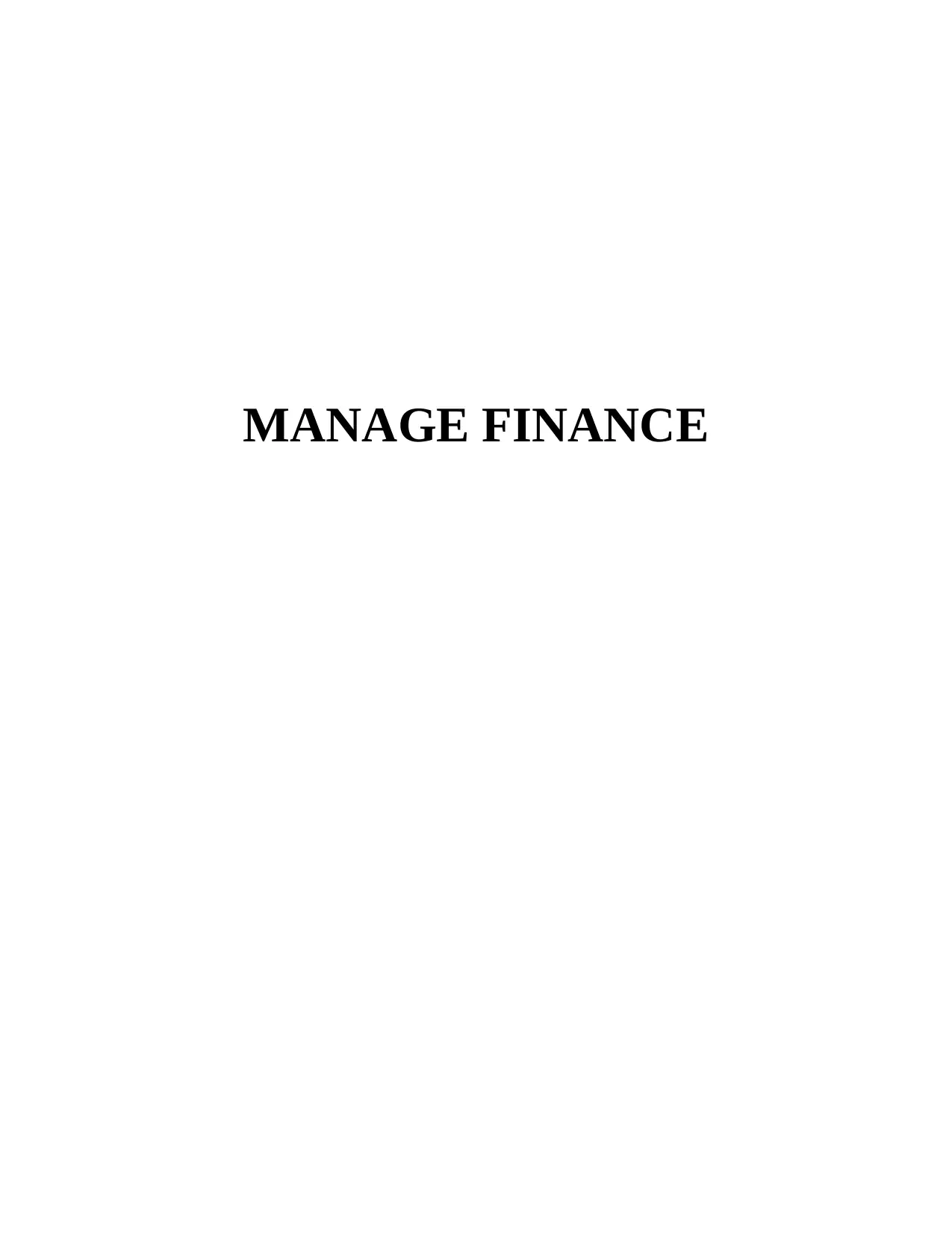
MANAGE FINANCE
Secure Best Marks with AI Grader
Need help grading? Try our AI Grader for instant feedback on your assignments.
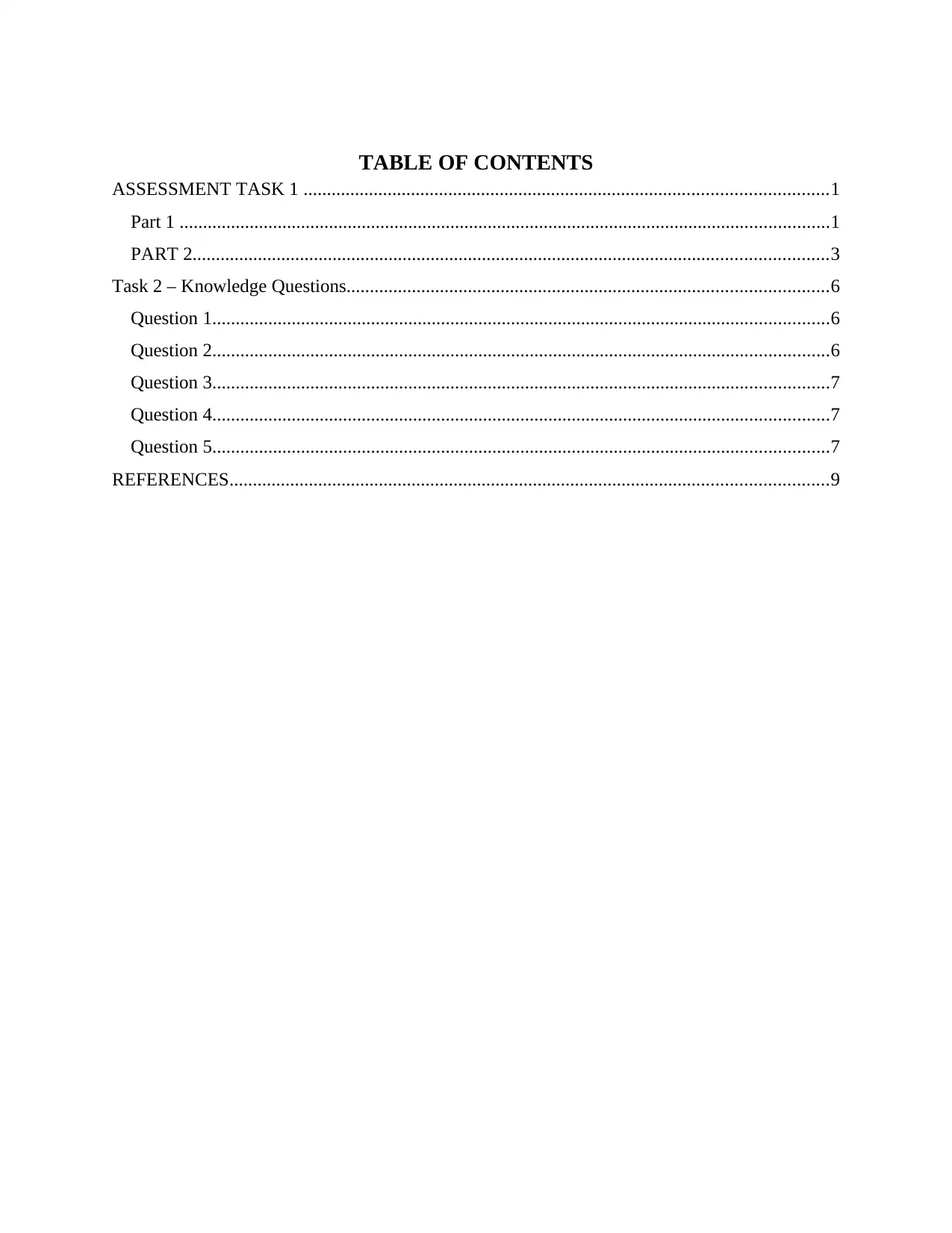
TABLE OF CONTENTS
ASSESSMENT TASK 1 ................................................................................................................1
Part 1 ...........................................................................................................................................1
PART 2........................................................................................................................................3
Task 2 – Knowledge Questions.......................................................................................................6
Question 1....................................................................................................................................6
Question 2....................................................................................................................................6
Question 3....................................................................................................................................7
Question 4....................................................................................................................................7
Question 5....................................................................................................................................7
REFERENCES................................................................................................................................9
ASSESSMENT TASK 1 ................................................................................................................1
Part 1 ...........................................................................................................................................1
PART 2........................................................................................................................................3
Task 2 – Knowledge Questions.......................................................................................................6
Question 1....................................................................................................................................6
Question 2....................................................................................................................................6
Question 3....................................................................................................................................7
Question 4....................................................................................................................................7
Question 5....................................................................................................................................7
REFERENCES................................................................................................................................9
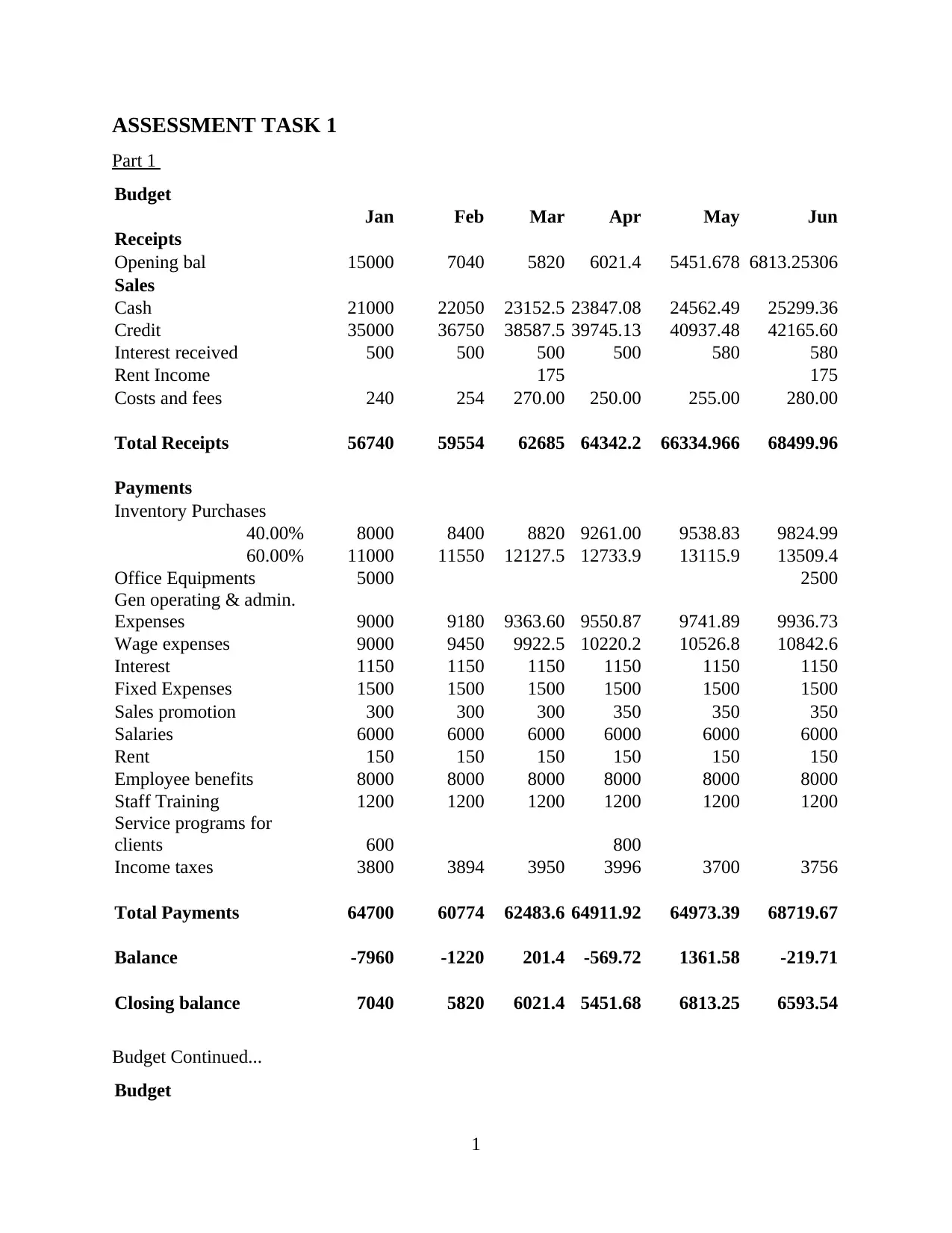
ASSESSMENT TASK 1
Part 1
Budget
Jan Feb Mar Apr May Jun
Receipts
Opening bal 15000 7040 5820 6021.4 5451.678 6813.25306
Sales
Cash 21000 22050 23152.5 23847.08 24562.49 25299.36
Credit 35000 36750 38587.5 39745.13 40937.48 42165.60
Interest received 500 500 500 500 580 580
Rent Income 175 175
Costs and fees 240 254 270.00 250.00 255.00 280.00
Total Receipts 56740 59554 62685 64342.2 66334.966 68499.96
Payments
Inventory Purchases
40.00% 8000 8400 8820 9261.00 9538.83 9824.99
60.00% 11000 11550 12127.5 12733.9 13115.9 13509.4
Office Equipments 5000 2500
Gen operating & admin.
Expenses 9000 9180 9363.60 9550.87 9741.89 9936.73
Wage expenses 9000 9450 9922.5 10220.2 10526.8 10842.6
Interest 1150 1150 1150 1150 1150 1150
Fixed Expenses 1500 1500 1500 1500 1500 1500
Sales promotion 300 300 300 350 350 350
Salaries 6000 6000 6000 6000 6000 6000
Rent 150 150 150 150 150 150
Employee benefits 8000 8000 8000 8000 8000 8000
Staff Training 1200 1200 1200 1200 1200 1200
Service programs for
clients 600 800
Income taxes 3800 3894 3950 3996 3700 3756
Total Payments 64700 60774 62483.6 64911.92 64973.39 68719.67
Balance -7960 -1220 201.4 -569.72 1361.58 -219.71
Closing balance 7040 5820 6021.4 5451.68 6813.25 6593.54
Budget Continued...
Budget
1
Part 1
Budget
Jan Feb Mar Apr May Jun
Receipts
Opening bal 15000 7040 5820 6021.4 5451.678 6813.25306
Sales
Cash 21000 22050 23152.5 23847.08 24562.49 25299.36
Credit 35000 36750 38587.5 39745.13 40937.48 42165.60
Interest received 500 500 500 500 580 580
Rent Income 175 175
Costs and fees 240 254 270.00 250.00 255.00 280.00
Total Receipts 56740 59554 62685 64342.2 66334.966 68499.96
Payments
Inventory Purchases
40.00% 8000 8400 8820 9261.00 9538.83 9824.99
60.00% 11000 11550 12127.5 12733.9 13115.9 13509.4
Office Equipments 5000 2500
Gen operating & admin.
Expenses 9000 9180 9363.60 9550.87 9741.89 9936.73
Wage expenses 9000 9450 9922.5 10220.2 10526.8 10842.6
Interest 1150 1150 1150 1150 1150 1150
Fixed Expenses 1500 1500 1500 1500 1500 1500
Sales promotion 300 300 300 350 350 350
Salaries 6000 6000 6000 6000 6000 6000
Rent 150 150 150 150 150 150
Employee benefits 8000 8000 8000 8000 8000 8000
Staff Training 1200 1200 1200 1200 1200 1200
Service programs for
clients 600 800
Income taxes 3800 3894 3950 3996 3700 3756
Total Payments 64700 60774 62483.6 64911.92 64973.39 68719.67
Balance -7960 -1220 201.4 -569.72 1361.58 -219.71
Closing balance 7040 5820 6021.4 5451.68 6813.25 6593.54
Budget Continued...
Budget
1
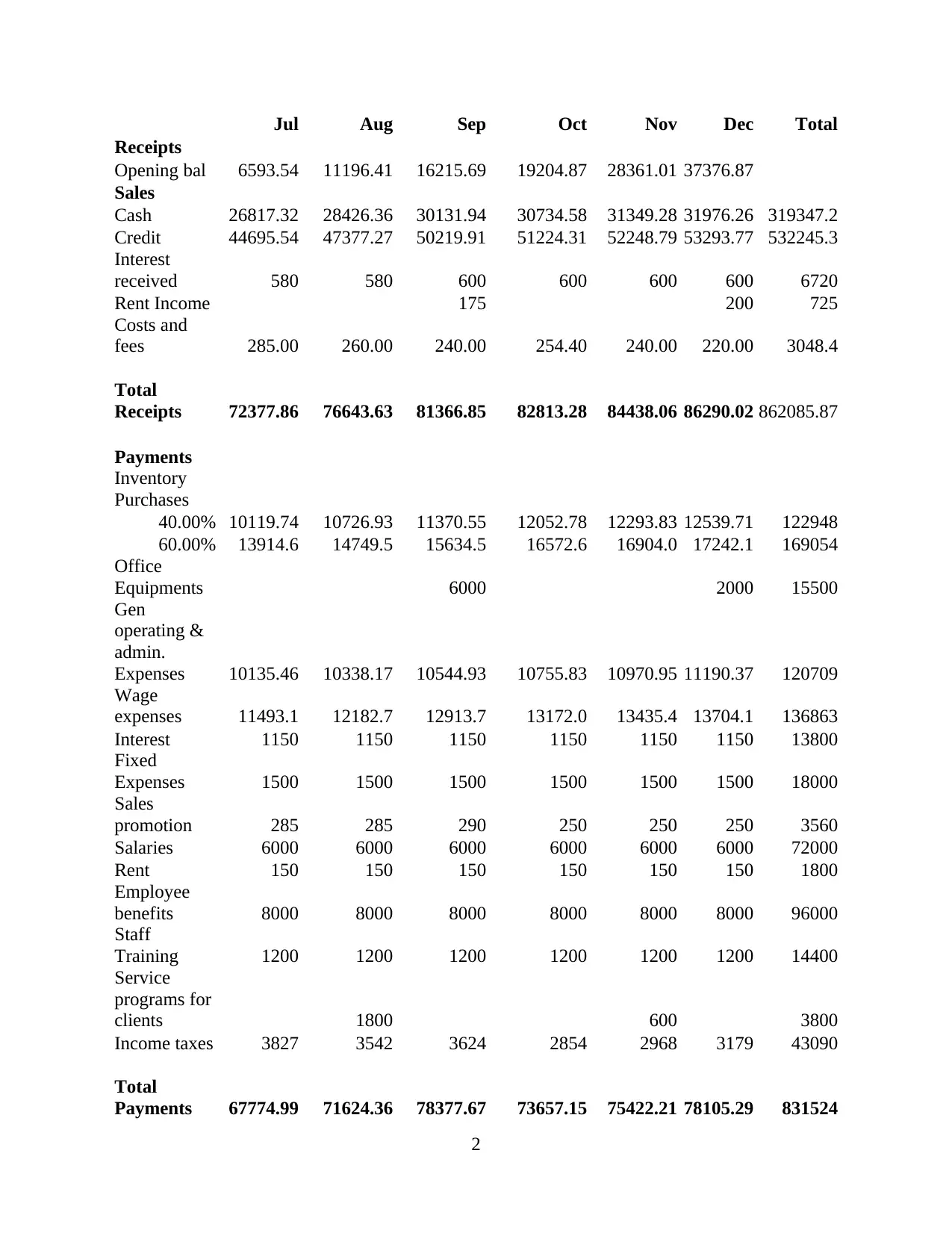
Jul Aug Sep Oct Nov Dec Total
Receipts
Opening bal 6593.54 11196.41 16215.69 19204.87 28361.01 37376.87
Sales
Cash 26817.32 28426.36 30131.94 30734.58 31349.28 31976.26 319347.2
Credit 44695.54 47377.27 50219.91 51224.31 52248.79 53293.77 532245.3
Interest
received 580 580 600 600 600 600 6720
Rent Income 175 200 725
Costs and
fees 285.00 260.00 240.00 254.40 240.00 220.00 3048.4
Total
Receipts 72377.86 76643.63 81366.85 82813.28 84438.06 86290.02 862085.87
Payments
Inventory
Purchases
40.00% 10119.74 10726.93 11370.55 12052.78 12293.83 12539.71 122948
60.00% 13914.6 14749.5 15634.5 16572.6 16904.0 17242.1 169054
Office
Equipments 6000 2000 15500
Gen
operating &
admin.
Expenses 10135.46 10338.17 10544.93 10755.83 10970.95 11190.37 120709
Wage
expenses 11493.1 12182.7 12913.7 13172.0 13435.4 13704.1 136863
Interest 1150 1150 1150 1150 1150 1150 13800
Fixed
Expenses 1500 1500 1500 1500 1500 1500 18000
Sales
promotion 285 285 290 250 250 250 3560
Salaries 6000 6000 6000 6000 6000 6000 72000
Rent 150 150 150 150 150 150 1800
Employee
benefits 8000 8000 8000 8000 8000 8000 96000
Staff
Training 1200 1200 1200 1200 1200 1200 14400
Service
programs for
clients 1800 600 3800
Income taxes 3827 3542 3624 2854 2968 3179 43090
Total
Payments 67774.99 71624.36 78377.67 73657.15 75422.21 78105.29 831524
2
Receipts
Opening bal 6593.54 11196.41 16215.69 19204.87 28361.01 37376.87
Sales
Cash 26817.32 28426.36 30131.94 30734.58 31349.28 31976.26 319347.2
Credit 44695.54 47377.27 50219.91 51224.31 52248.79 53293.77 532245.3
Interest
received 580 580 600 600 600 600 6720
Rent Income 175 200 725
Costs and
fees 285.00 260.00 240.00 254.40 240.00 220.00 3048.4
Total
Receipts 72377.86 76643.63 81366.85 82813.28 84438.06 86290.02 862085.87
Payments
Inventory
Purchases
40.00% 10119.74 10726.93 11370.55 12052.78 12293.83 12539.71 122948
60.00% 13914.6 14749.5 15634.5 16572.6 16904.0 17242.1 169054
Office
Equipments 6000 2000 15500
Gen
operating &
admin.
Expenses 10135.46 10338.17 10544.93 10755.83 10970.95 11190.37 120709
Wage
expenses 11493.1 12182.7 12913.7 13172.0 13435.4 13704.1 136863
Interest 1150 1150 1150 1150 1150 1150 13800
Fixed
Expenses 1500 1500 1500 1500 1500 1500 18000
Sales
promotion 285 285 290 250 250 250 3560
Salaries 6000 6000 6000 6000 6000 6000 72000
Rent 150 150 150 150 150 150 1800
Employee
benefits 8000 8000 8000 8000 8000 8000 96000
Staff
Training 1200 1200 1200 1200 1200 1200 14400
Service
programs for
clients 1800 600 3800
Income taxes 3827 3542 3624 2854 2968 3179 43090
Total
Payments 67774.99 71624.36 78377.67 73657.15 75422.21 78105.29 831524
2
Secure Best Marks with AI Grader
Need help grading? Try our AI Grader for instant feedback on your assignments.
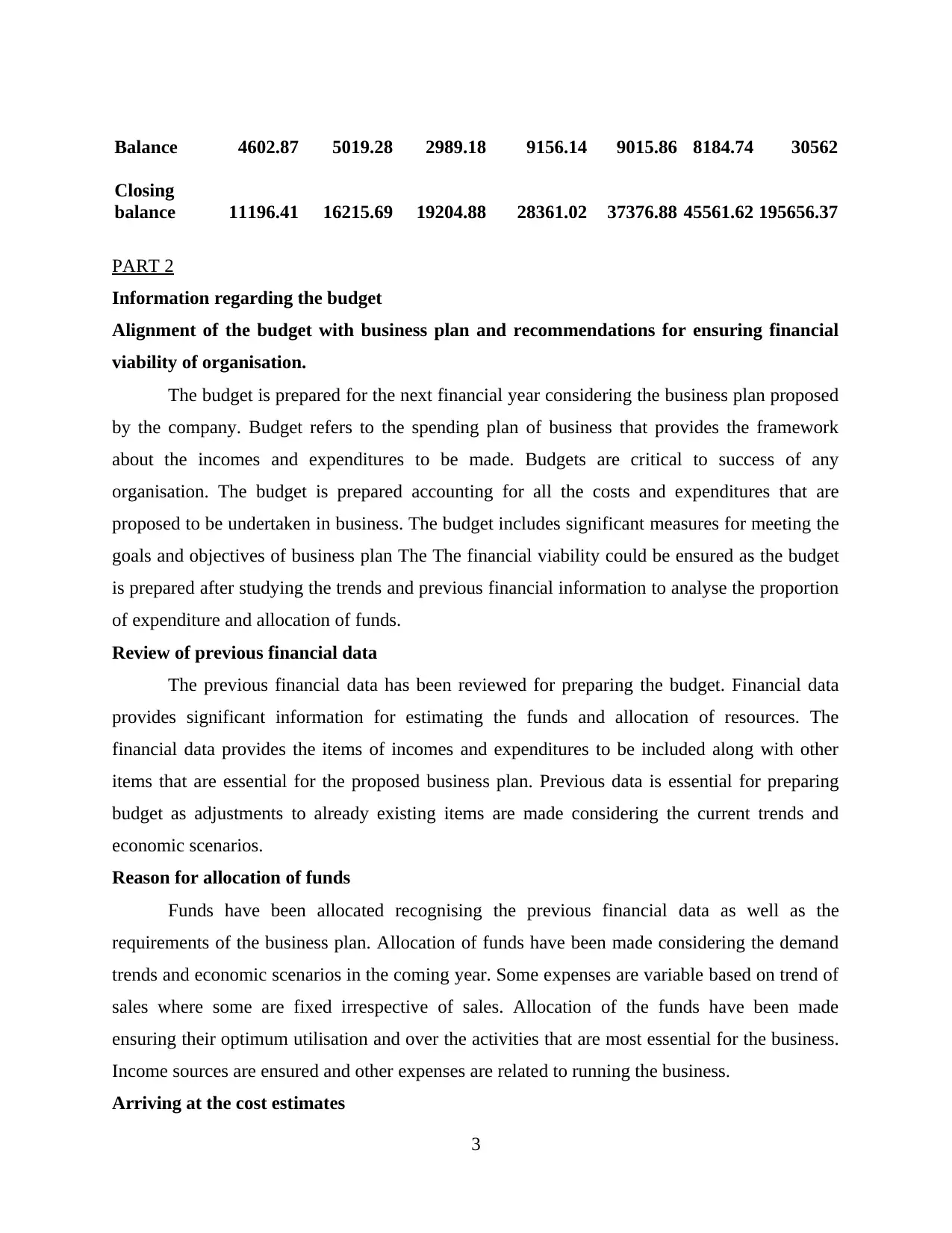
Balance 4602.87 5019.28 2989.18 9156.14 9015.86 8184.74 30562
Closing
balance 11196.41 16215.69 19204.88 28361.02 37376.88 45561.62 195656.37
PART 2
Information regarding the budget
Alignment of the budget with business plan and recommendations for ensuring financial
viability of organisation.
The budget is prepared for the next financial year considering the business plan proposed
by the company. Budget refers to the spending plan of business that provides the framework
about the incomes and expenditures to be made. Budgets are critical to success of any
organisation. The budget is prepared accounting for all the costs and expenditures that are
proposed to be undertaken in business. The budget includes significant measures for meeting the
goals and objectives of business plan The The financial viability could be ensured as the budget
is prepared after studying the trends and previous financial information to analyse the proportion
of expenditure and allocation of funds.
Review of previous financial data
The previous financial data has been reviewed for preparing the budget. Financial data
provides significant information for estimating the funds and allocation of resources. The
financial data provides the items of incomes and expenditures to be included along with other
items that are essential for the proposed business plan. Previous data is essential for preparing
budget as adjustments to already existing items are made considering the current trends and
economic scenarios.
Reason for allocation of funds
Funds have been allocated recognising the previous financial data as well as the
requirements of the business plan. Allocation of funds have been made considering the demand
trends and economic scenarios in the coming year. Some expenses are variable based on trend of
sales where some are fixed irrespective of sales. Allocation of the funds have been made
ensuring their optimum utilisation and over the activities that are most essential for the business.
Income sources are ensured and other expenses are related to running the business.
Arriving at the cost estimates
3
Closing
balance 11196.41 16215.69 19204.88 28361.02 37376.88 45561.62 195656.37
PART 2
Information regarding the budget
Alignment of the budget with business plan and recommendations for ensuring financial
viability of organisation.
The budget is prepared for the next financial year considering the business plan proposed
by the company. Budget refers to the spending plan of business that provides the framework
about the incomes and expenditures to be made. Budgets are critical to success of any
organisation. The budget is prepared accounting for all the costs and expenditures that are
proposed to be undertaken in business. The budget includes significant measures for meeting the
goals and objectives of business plan The The financial viability could be ensured as the budget
is prepared after studying the trends and previous financial information to analyse the proportion
of expenditure and allocation of funds.
Review of previous financial data
The previous financial data has been reviewed for preparing the budget. Financial data
provides significant information for estimating the funds and allocation of resources. The
financial data provides the items of incomes and expenditures to be included along with other
items that are essential for the proposed business plan. Previous data is essential for preparing
budget as adjustments to already existing items are made considering the current trends and
economic scenarios.
Reason for allocation of funds
Funds have been allocated recognising the previous financial data as well as the
requirements of the business plan. Allocation of funds have been made considering the demand
trends and economic scenarios in the coming year. Some expenses are variable based on trend of
sales where some are fixed irrespective of sales. Allocation of the funds have been made
ensuring their optimum utilisation and over the activities that are most essential for the business.
Income sources are ensured and other expenses are related to running the business.
Arriving at the cost estimates
3
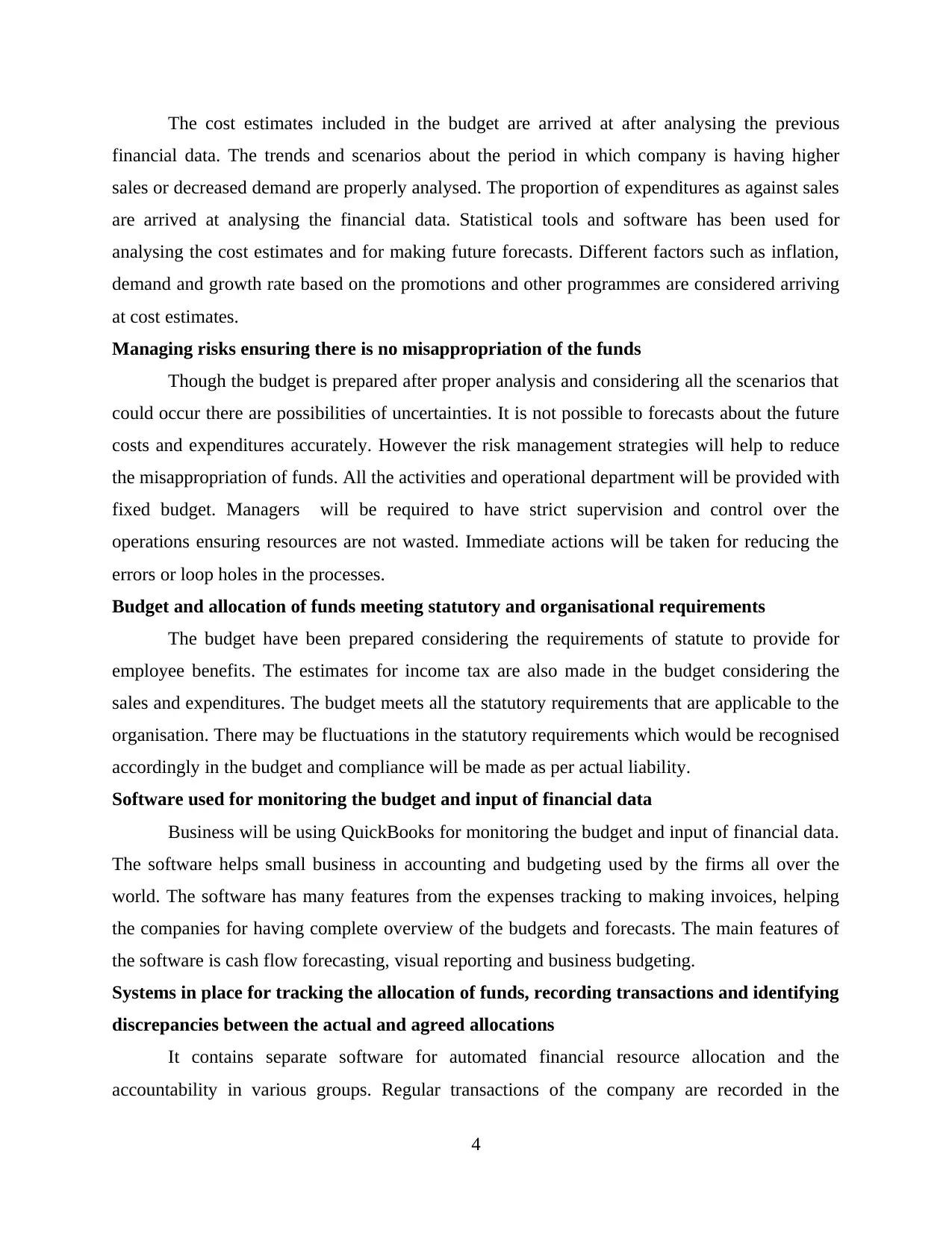
The cost estimates included in the budget are arrived at after analysing the previous
financial data. The trends and scenarios about the period in which company is having higher
sales or decreased demand are properly analysed. The proportion of expenditures as against sales
are arrived at analysing the financial data. Statistical tools and software has been used for
analysing the cost estimates and for making future forecasts. Different factors such as inflation,
demand and growth rate based on the promotions and other programmes are considered arriving
at cost estimates.
Managing risks ensuring there is no misappropriation of the funds
Though the budget is prepared after proper analysis and considering all the scenarios that
could occur there are possibilities of uncertainties. It is not possible to forecasts about the future
costs and expenditures accurately. However the risk management strategies will help to reduce
the misappropriation of funds. All the activities and operational department will be provided with
fixed budget. Managers will be required to have strict supervision and control over the
operations ensuring resources are not wasted. Immediate actions will be taken for reducing the
errors or loop holes in the processes.
Budget and allocation of funds meeting statutory and organisational requirements
The budget have been prepared considering the requirements of statute to provide for
employee benefits. The estimates for income tax are also made in the budget considering the
sales and expenditures. The budget meets all the statutory requirements that are applicable to the
organisation. There may be fluctuations in the statutory requirements which would be recognised
accordingly in the budget and compliance will be made as per actual liability.
Software used for monitoring the budget and input of financial data
Business will be using QuickBooks for monitoring the budget and input of financial data.
The software helps small business in accounting and budgeting used by the firms all over the
world. The software has many features from the expenses tracking to making invoices, helping
the companies for having complete overview of the budgets and forecasts. The main features of
the software is cash flow forecasting, visual reporting and business budgeting.
Systems in place for tracking the allocation of funds, recording transactions and identifying
discrepancies between the actual and agreed allocations
It contains separate software for automated financial resource allocation and the
accountability in various groups. Regular transactions of the company are recorded in the
4
financial data. The trends and scenarios about the period in which company is having higher
sales or decreased demand are properly analysed. The proportion of expenditures as against sales
are arrived at analysing the financial data. Statistical tools and software has been used for
analysing the cost estimates and for making future forecasts. Different factors such as inflation,
demand and growth rate based on the promotions and other programmes are considered arriving
at cost estimates.
Managing risks ensuring there is no misappropriation of the funds
Though the budget is prepared after proper analysis and considering all the scenarios that
could occur there are possibilities of uncertainties. It is not possible to forecasts about the future
costs and expenditures accurately. However the risk management strategies will help to reduce
the misappropriation of funds. All the activities and operational department will be provided with
fixed budget. Managers will be required to have strict supervision and control over the
operations ensuring resources are not wasted. Immediate actions will be taken for reducing the
errors or loop holes in the processes.
Budget and allocation of funds meeting statutory and organisational requirements
The budget have been prepared considering the requirements of statute to provide for
employee benefits. The estimates for income tax are also made in the budget considering the
sales and expenditures. The budget meets all the statutory requirements that are applicable to the
organisation. There may be fluctuations in the statutory requirements which would be recognised
accordingly in the budget and compliance will be made as per actual liability.
Software used for monitoring the budget and input of financial data
Business will be using QuickBooks for monitoring the budget and input of financial data.
The software helps small business in accounting and budgeting used by the firms all over the
world. The software has many features from the expenses tracking to making invoices, helping
the companies for having complete overview of the budgets and forecasts. The main features of
the software is cash flow forecasting, visual reporting and business budgeting.
Systems in place for tracking the allocation of funds, recording transactions and identifying
discrepancies between the actual and agreed allocations
It contains separate software for automated financial resource allocation and the
accountability in various groups. Regular transactions of the company are recorded in the
4
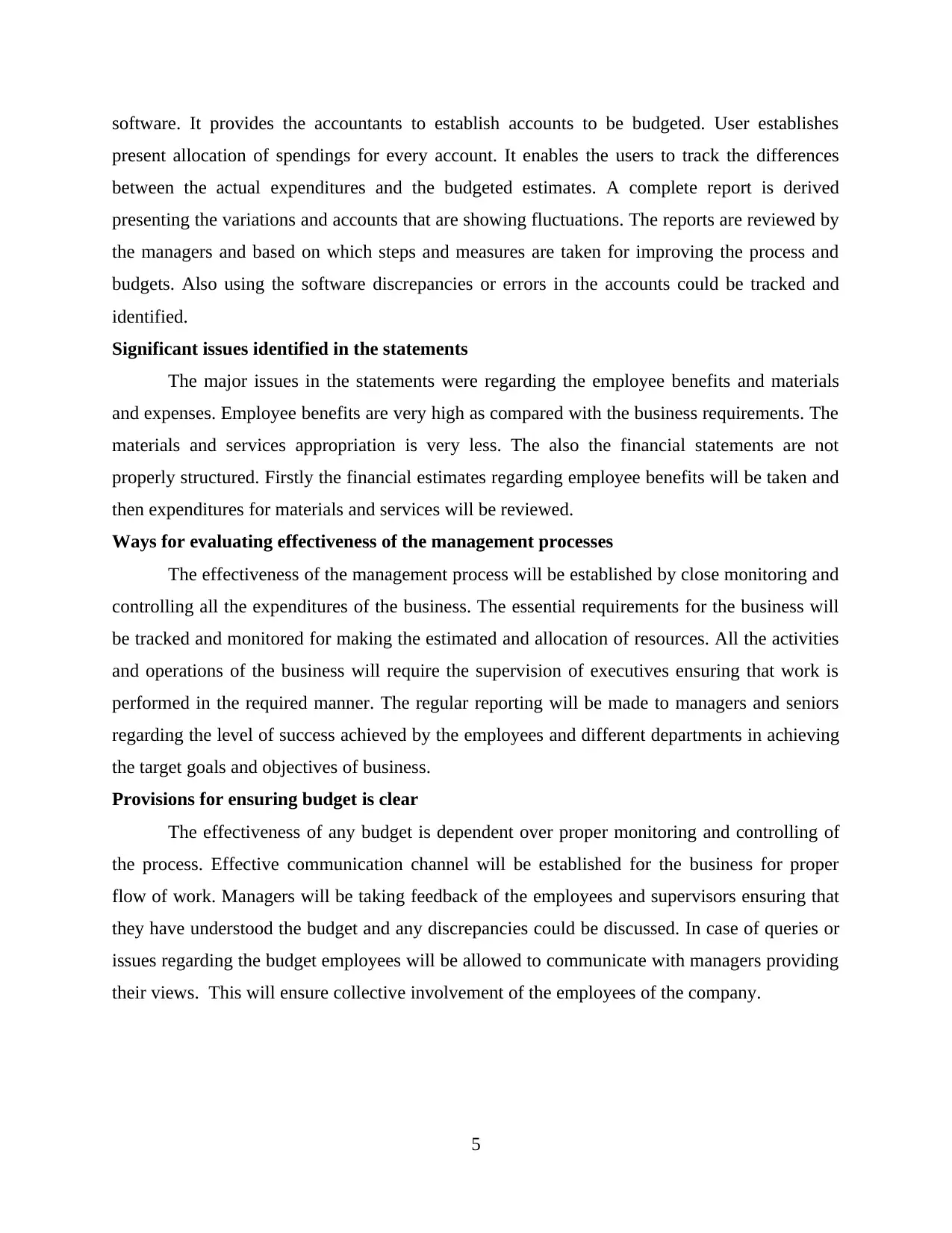
software. It provides the accountants to establish accounts to be budgeted. User establishes
present allocation of spendings for every account. It enables the users to track the differences
between the actual expenditures and the budgeted estimates. A complete report is derived
presenting the variations and accounts that are showing fluctuations. The reports are reviewed by
the managers and based on which steps and measures are taken for improving the process and
budgets. Also using the software discrepancies or errors in the accounts could be tracked and
identified.
Significant issues identified in the statements
The major issues in the statements were regarding the employee benefits and materials
and expenses. Employee benefits are very high as compared with the business requirements. The
materials and services appropriation is very less. The also the financial statements are not
properly structured. Firstly the financial estimates regarding employee benefits will be taken and
then expenditures for materials and services will be reviewed.
Ways for evaluating effectiveness of the management processes
The effectiveness of the management process will be established by close monitoring and
controlling all the expenditures of the business. The essential requirements for the business will
be tracked and monitored for making the estimated and allocation of resources. All the activities
and operations of the business will require the supervision of executives ensuring that work is
performed in the required manner. The regular reporting will be made to managers and seniors
regarding the level of success achieved by the employees and different departments in achieving
the target goals and objectives of business.
Provisions for ensuring budget is clear
The effectiveness of any budget is dependent over proper monitoring and controlling of
the process. Effective communication channel will be established for the business for proper
flow of work. Managers will be taking feedback of the employees and supervisors ensuring that
they have understood the budget and any discrepancies could be discussed. In case of queries or
issues regarding the budget employees will be allowed to communicate with managers providing
their views. This will ensure collective involvement of the employees of the company.
5
present allocation of spendings for every account. It enables the users to track the differences
between the actual expenditures and the budgeted estimates. A complete report is derived
presenting the variations and accounts that are showing fluctuations. The reports are reviewed by
the managers and based on which steps and measures are taken for improving the process and
budgets. Also using the software discrepancies or errors in the accounts could be tracked and
identified.
Significant issues identified in the statements
The major issues in the statements were regarding the employee benefits and materials
and expenses. Employee benefits are very high as compared with the business requirements. The
materials and services appropriation is very less. The also the financial statements are not
properly structured. Firstly the financial estimates regarding employee benefits will be taken and
then expenditures for materials and services will be reviewed.
Ways for evaluating effectiveness of the management processes
The effectiveness of the management process will be established by close monitoring and
controlling all the expenditures of the business. The essential requirements for the business will
be tracked and monitored for making the estimated and allocation of resources. All the activities
and operations of the business will require the supervision of executives ensuring that work is
performed in the required manner. The regular reporting will be made to managers and seniors
regarding the level of success achieved by the employees and different departments in achieving
the target goals and objectives of business.
Provisions for ensuring budget is clear
The effectiveness of any budget is dependent over proper monitoring and controlling of
the process. Effective communication channel will be established for the business for proper
flow of work. Managers will be taking feedback of the employees and supervisors ensuring that
they have understood the budget and any discrepancies could be discussed. In case of queries or
issues regarding the budget employees will be allowed to communicate with managers providing
their views. This will ensure collective involvement of the employees of the company.
5
Paraphrase This Document
Need a fresh take? Get an instant paraphrase of this document with our AI Paraphraser
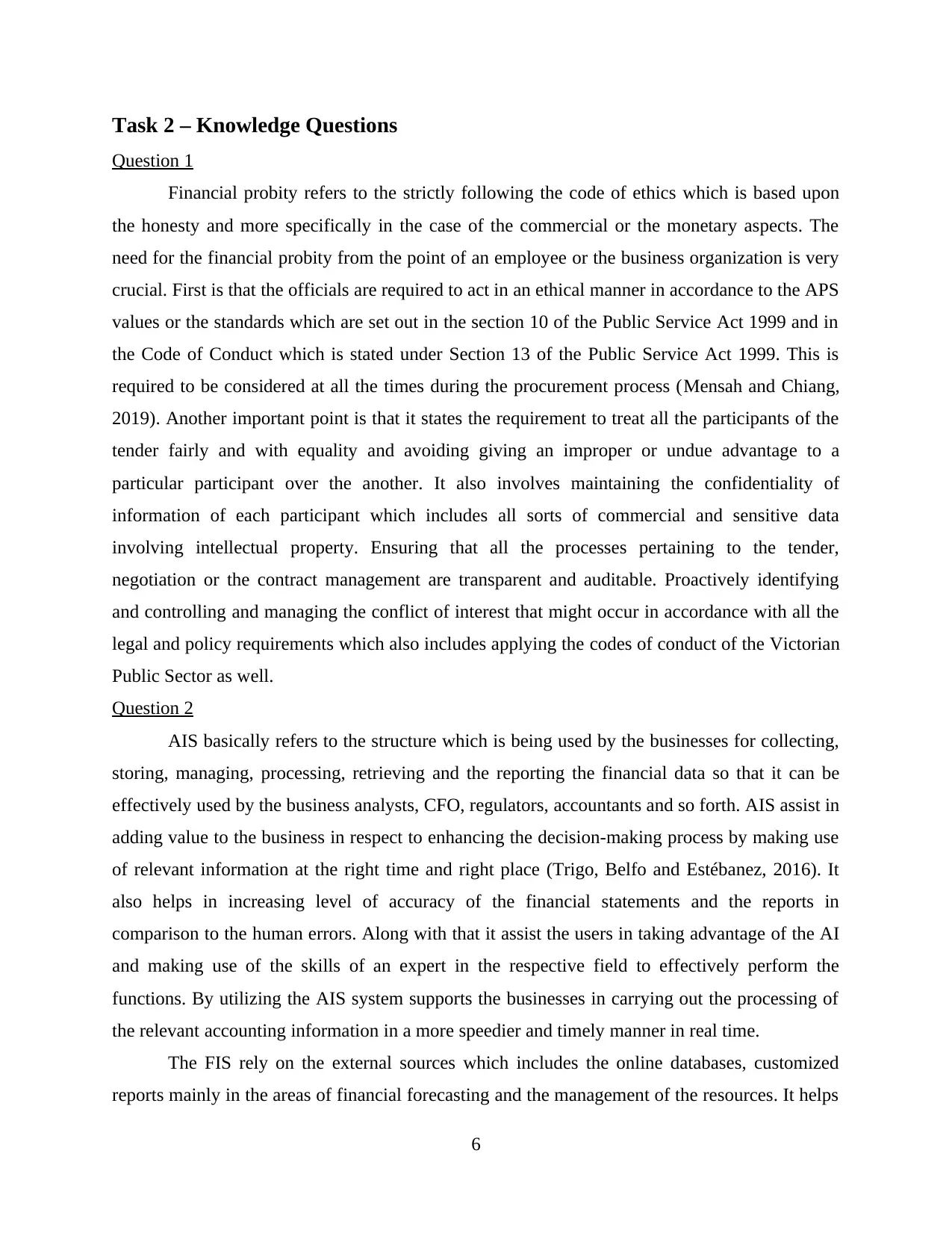
Task 2 – Knowledge Questions
Question 1
Financial probity refers to the strictly following the code of ethics which is based upon
the honesty and more specifically in the case of the commercial or the monetary aspects. The
need for the financial probity from the point of an employee or the business organization is very
crucial. First is that the officials are required to act in an ethical manner in accordance to the APS
values or the standards which are set out in the section 10 of the Public Service Act 1999 and in
the Code of Conduct which is stated under Section 13 of the Public Service Act 1999. This is
required to be considered at all the times during the procurement process (Mensah and Chiang,
2019). Another important point is that it states the requirement to treat all the participants of the
tender fairly and with equality and avoiding giving an improper or undue advantage to a
particular participant over the another. It also involves maintaining the confidentiality of
information of each participant which includes all sorts of commercial and sensitive data
involving intellectual property. Ensuring that all the processes pertaining to the tender,
negotiation or the contract management are transparent and auditable. Proactively identifying
and controlling and managing the conflict of interest that might occur in accordance with all the
legal and policy requirements which also includes applying the codes of conduct of the Victorian
Public Sector as well.
Question 2
AIS basically refers to the structure which is being used by the businesses for collecting,
storing, managing, processing, retrieving and the reporting the financial data so that it can be
effectively used by the business analysts, CFO, regulators, accountants and so forth. AIS assist in
adding value to the business in respect to enhancing the decision-making process by making use
of relevant information at the right time and right place (Trigo, Belfo and Estébanez, 2016). It
also helps in increasing level of accuracy of the financial statements and the reports in
comparison to the human errors. Along with that it assist the users in taking advantage of the AI
and making use of the skills of an expert in the respective field to effectively perform the
functions. By utilizing the AIS system supports the businesses in carrying out the processing of
the relevant accounting information in a more speedier and timely manner in real time.
The FIS rely on the external sources which includes the online databases, customized
reports mainly in the areas of financial forecasting and the management of the resources. It helps
6
Question 1
Financial probity refers to the strictly following the code of ethics which is based upon
the honesty and more specifically in the case of the commercial or the monetary aspects. The
need for the financial probity from the point of an employee or the business organization is very
crucial. First is that the officials are required to act in an ethical manner in accordance to the APS
values or the standards which are set out in the section 10 of the Public Service Act 1999 and in
the Code of Conduct which is stated under Section 13 of the Public Service Act 1999. This is
required to be considered at all the times during the procurement process (Mensah and Chiang,
2019). Another important point is that it states the requirement to treat all the participants of the
tender fairly and with equality and avoiding giving an improper or undue advantage to a
particular participant over the another. It also involves maintaining the confidentiality of
information of each participant which includes all sorts of commercial and sensitive data
involving intellectual property. Ensuring that all the processes pertaining to the tender,
negotiation or the contract management are transparent and auditable. Proactively identifying
and controlling and managing the conflict of interest that might occur in accordance with all the
legal and policy requirements which also includes applying the codes of conduct of the Victorian
Public Sector as well.
Question 2
AIS basically refers to the structure which is being used by the businesses for collecting,
storing, managing, processing, retrieving and the reporting the financial data so that it can be
effectively used by the business analysts, CFO, regulators, accountants and so forth. AIS assist in
adding value to the business in respect to enhancing the decision-making process by making use
of relevant information at the right time and right place (Trigo, Belfo and Estébanez, 2016). It
also helps in increasing level of accuracy of the financial statements and the reports in
comparison to the human errors. Along with that it assist the users in taking advantage of the AI
and making use of the skills of an expert in the respective field to effectively perform the
functions. By utilizing the AIS system supports the businesses in carrying out the processing of
the relevant accounting information in a more speedier and timely manner in real time.
The FIS rely on the external sources which includes the online databases, customized
reports mainly in the areas of financial forecasting and the management of the resources. It helps
6
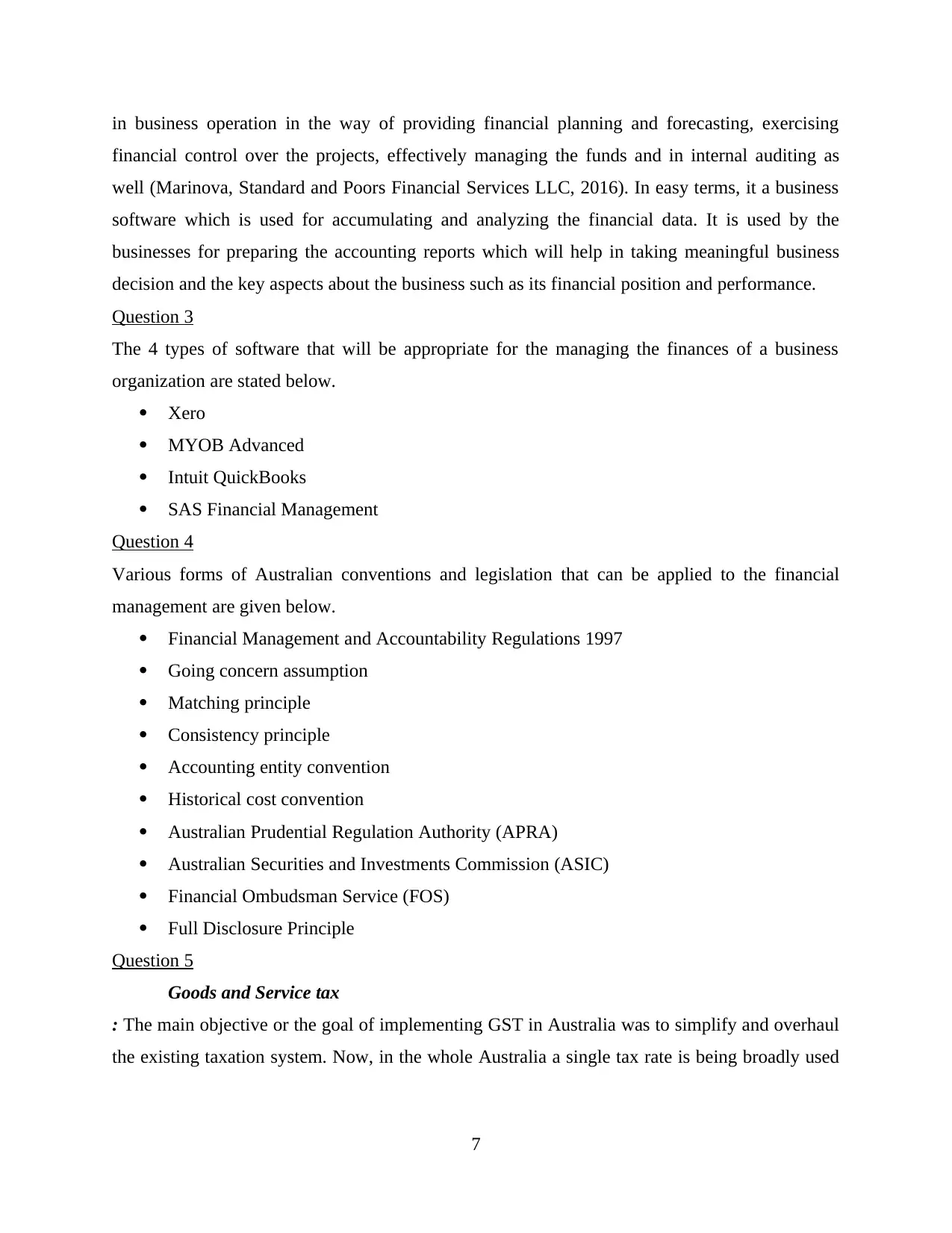
in business operation in the way of providing financial planning and forecasting, exercising
financial control over the projects, effectively managing the funds and in internal auditing as
well (Marinova, Standard and Poors Financial Services LLC, 2016). In easy terms, it a business
software which is used for accumulating and analyzing the financial data. It is used by the
businesses for preparing the accounting reports which will help in taking meaningful business
decision and the key aspects about the business such as its financial position and performance.
Question 3
The 4 types of software that will be appropriate for the managing the finances of a business
organization are stated below.
Xero
MYOB Advanced
Intuit QuickBooks
SAS Financial Management
Question 4
Various forms of Australian conventions and legislation that can be applied to the financial
management are given below.
Financial Management and Accountability Regulations 1997
Going concern assumption
Matching principle
Consistency principle
Accounting entity convention
Historical cost convention
Australian Prudential Regulation Authority (APRA)
Australian Securities and Investments Commission (ASIC)
Financial Ombudsman Service (FOS)
Full Disclosure Principle
Question 5
Goods and Service tax
: The main objective or the goal of implementing GST in Australia was to simplify and overhaul
the existing taxation system. Now, in the whole Australia a single tax rate is being broadly used
7
financial control over the projects, effectively managing the funds and in internal auditing as
well (Marinova, Standard and Poors Financial Services LLC, 2016). In easy terms, it a business
software which is used for accumulating and analyzing the financial data. It is used by the
businesses for preparing the accounting reports which will help in taking meaningful business
decision and the key aspects about the business such as its financial position and performance.
Question 3
The 4 types of software that will be appropriate for the managing the finances of a business
organization are stated below.
Xero
MYOB Advanced
Intuit QuickBooks
SAS Financial Management
Question 4
Various forms of Australian conventions and legislation that can be applied to the financial
management are given below.
Financial Management and Accountability Regulations 1997
Going concern assumption
Matching principle
Consistency principle
Accounting entity convention
Historical cost convention
Australian Prudential Regulation Authority (APRA)
Australian Securities and Investments Commission (ASIC)
Financial Ombudsman Service (FOS)
Full Disclosure Principle
Question 5
Goods and Service tax
: The main objective or the goal of implementing GST in Australia was to simplify and overhaul
the existing taxation system. Now, in the whole Australia a single tax rate is being broadly used
7
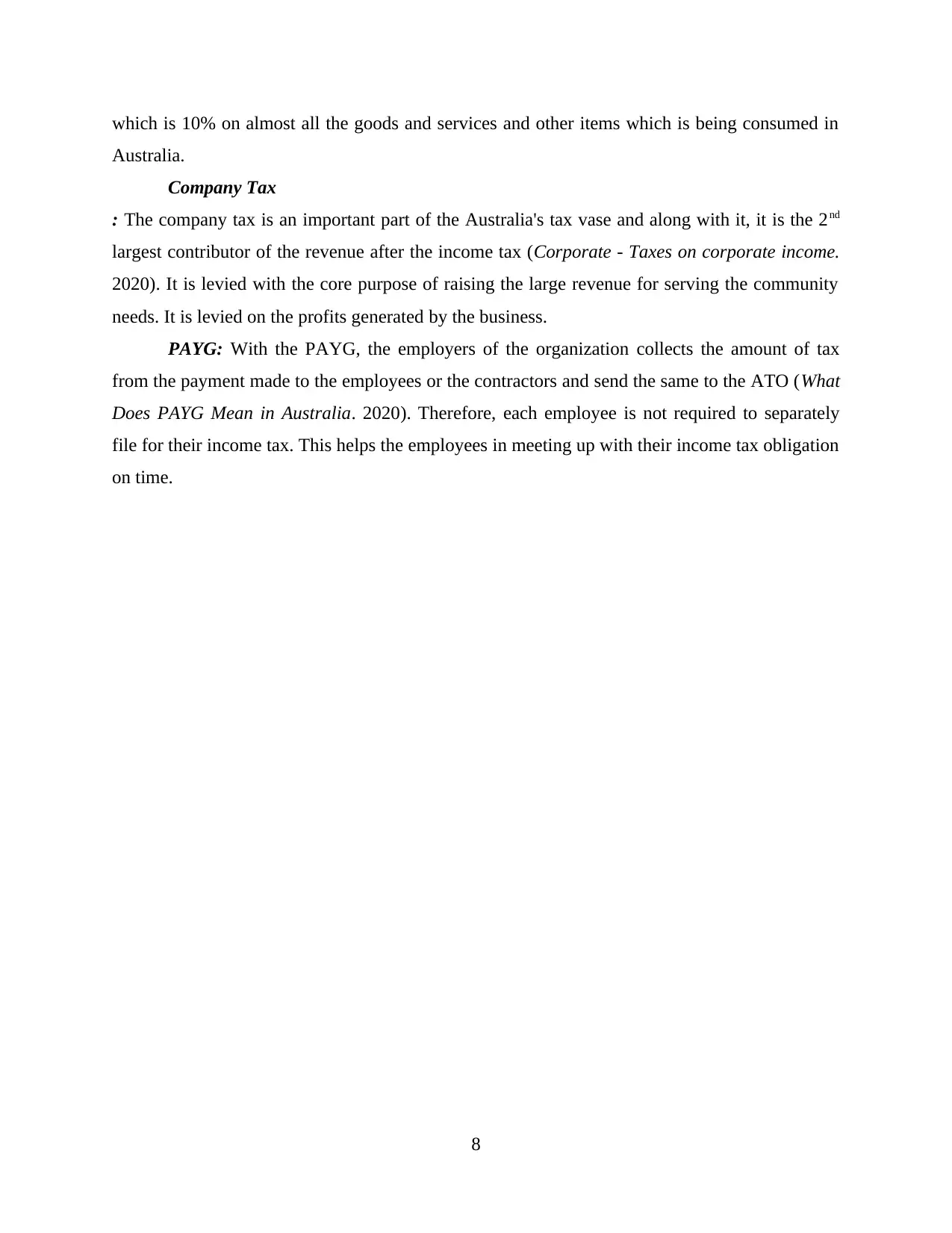
which is 10% on almost all the goods and services and other items which is being consumed in
Australia.
Company Tax
: The company tax is an important part of the Australia's tax vase and along with it, it is the 2nd
largest contributor of the revenue after the income tax (Corporate - Taxes on corporate income.
2020). It is levied with the core purpose of raising the large revenue for serving the community
needs. It is levied on the profits generated by the business.
PAYG: With the PAYG, the employers of the organization collects the amount of tax
from the payment made to the employees or the contractors and send the same to the ATO (What
Does PAYG Mean in Australia. 2020). Therefore, each employee is not required to separately
file for their income tax. This helps the employees in meeting up with their income tax obligation
on time.
8
Australia.
Company Tax
: The company tax is an important part of the Australia's tax vase and along with it, it is the 2nd
largest contributor of the revenue after the income tax (Corporate - Taxes on corporate income.
2020). It is levied with the core purpose of raising the large revenue for serving the community
needs. It is levied on the profits generated by the business.
PAYG: With the PAYG, the employers of the organization collects the amount of tax
from the payment made to the employees or the contractors and send the same to the ATO (What
Does PAYG Mean in Australia. 2020). Therefore, each employee is not required to separately
file for their income tax. This helps the employees in meeting up with their income tax obligation
on time.
8
Secure Best Marks with AI Grader
Need help grading? Try our AI Grader for instant feedback on your assignments.

REFERENCES
Books and Journals
Mensah, Y. M. and Chiang, C. C., 2019. The Pendulum Effects of Legislation on the Probity of
Financial Statements.
Trigo, A., Belfo, F. and Estébanez, R. P., 2016. Accounting Information Systems: evolving
towards a business process oriented accounting. Procedia Computer Science. 100.
pp.987-994.
Marinova, S., Standard and Poors Financial Services LLC, 2016. Financial Information
Management System and User Interface. U.S. Patent Application 14/896,648.
Online
Corporate - Taxes on corporate income. 2020. [Online]. Available
Through:<https://taxsummaries.pwc.com/australia/corporate/taxes-on-corporate-
income>.
What Does PAYG Mean in Australia. 2020. [Online]. Available
Through:<https://meadpartners.com.au/what-does-payg-mean-in-australia/>.
9
Books and Journals
Mensah, Y. M. and Chiang, C. C., 2019. The Pendulum Effects of Legislation on the Probity of
Financial Statements.
Trigo, A., Belfo, F. and Estébanez, R. P., 2016. Accounting Information Systems: evolving
towards a business process oriented accounting. Procedia Computer Science. 100.
pp.987-994.
Marinova, S., Standard and Poors Financial Services LLC, 2016. Financial Information
Management System and User Interface. U.S. Patent Application 14/896,648.
Online
Corporate - Taxes on corporate income. 2020. [Online]. Available
Through:<https://taxsummaries.pwc.com/australia/corporate/taxes-on-corporate-
income>.
What Does PAYG Mean in Australia. 2020. [Online]. Available
Through:<https://meadpartners.com.au/what-does-payg-mean-in-australia/>.
9
1 out of 11
Your All-in-One AI-Powered Toolkit for Academic Success.
+13062052269
info@desklib.com
Available 24*7 on WhatsApp / Email
![[object Object]](/_next/static/media/star-bottom.7253800d.svg)
Unlock your academic potential
© 2024 | Zucol Services PVT LTD | All rights reserved.
